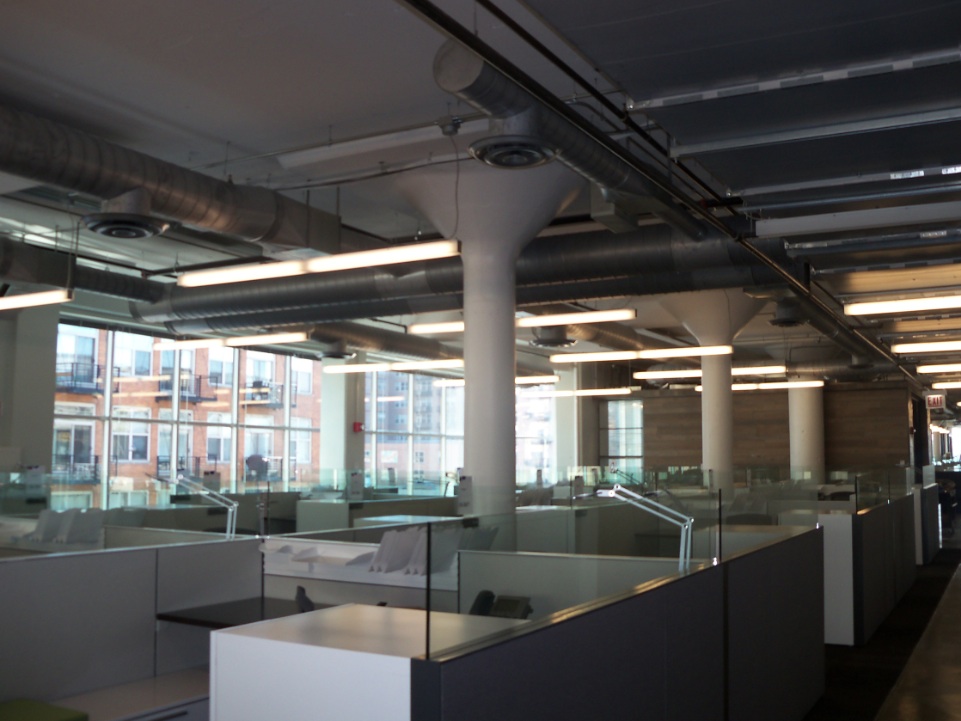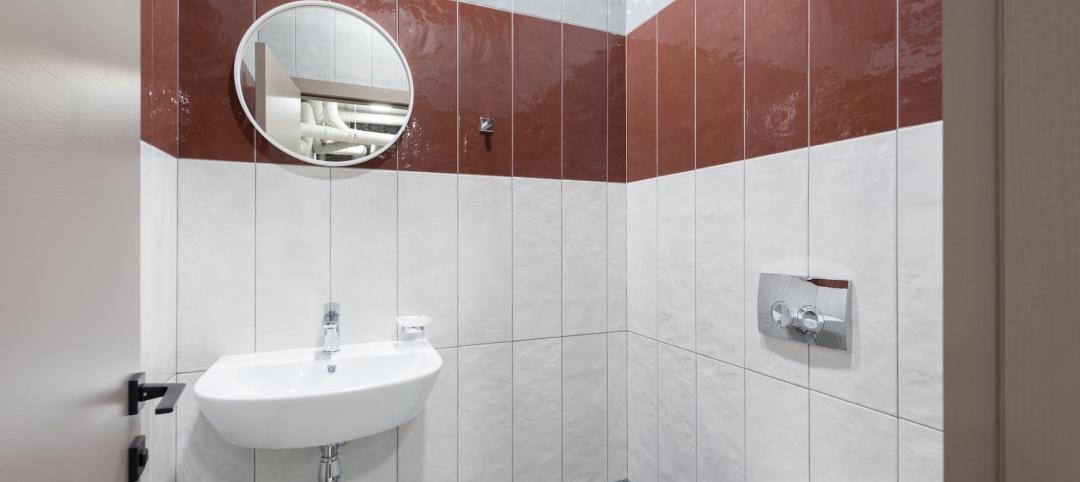When Sara Lee Corp. changed its name to Hillshire Brands and relocated from the suburbs to downtown Chicago in December 2012, the company gained a new lease on life.
Hillshire moved a portion of its corporate headquarters into the newly renovated, four-story 400 South Jefferson Street building in the city’s West Loop. Built in 1944 for the Newman-Rudolph Lithographing Co., the 230,000-sf structure was stripped down to its cast-in-place concrete frame and rebuilt with a modern glass curtain wall façade, new passenger elevators, major building system updates, and an indoor parking garage.
The $70 million, fast-track project—led by Proteus Group (architect, core and shell), Leopardo (general contractor, core and shell), Perkins+Will (architect, interior build-out), Clune (general contractor, interior build-out), Sterling Bay Cos. (owner/developer), Environmental Systems Design (MEP/FP), Project Management Advisors (project management), and Colliers (tenant representative)—was completed in just 10 months using a BIM/VDC/IPD workflow.
The core and shell team had the full 10 months to complete its portion of the project, but the interior build-out team had just four months. The interior work entailed four general office floors, three test kitchens, and a tower housing conference rooms.
Initially, the base building contractor modeled the as-built conditions using BIM, after which the interior design was added by Perkins+Will, before releasing the model to Environmental Systems Design. ESD had just four weeks to complete bid and permit documentation for the building’s MEP and fire protection systems.
5 Tips for collaborating with BIM
1. All consultants working in BIM should coordinate during architectural model development, rather than after completion of the architectural model. Communicating your expectations prevents coordination issues from occurring later in the project design. In the case of the Hillshire HQ project, the architects and engineers met before the BIM model was initiated to talk about past concerns and project design expectations.2. Set up trade drawing sheets at the start of the project. Designers often forget to set up trade drawing sheets and don’t think about them until the end of the project when they want to print. The absence of trade drawing sheets can hold up a project. As cool as the 3D model is, the 2D drawing is what everyone will use after the design has been completed.3. BIM programs are not CAD; don’t use them as if they were. Most AEC professionals learn how to design in 2D CAD, so when moving into BIM they try to replicate what is done in CAD, like drawing text boxes, without utilizing the “smarts” in BIM. In addition, understand that you’re working in a 3D environment and you need to pay attention to the “Z” axis, or the vertical plane. For the first time, height needs to be defined. How high are you mounting the ductwork or the light fixture? Those questions need to be answered early on.4. Use BIM to create ventilation schedules. Take advantage of the information already held in the model, such as the defined volume and ceiling height of each room. Let the BIM model fill out ventilation schedules and calculate air quantities of individual air terminals.5. Set up electrical equipment properties and panel schedules at the beginning. This speeds up circuiting in the end. Every time a piece of equipment is placed into the BIM model, fill in the information about the piece of equipment from the start so that schedules auto-populate at the end.— Amanda Carter
Could BIM really speed up design, eliminate coordination issues among the trades, and limit requests for information during construction? ESD set out to find the answer.
Beginning with Autodesk’s Revit MEP, ESD engineers created a 3D interactive model. Using Revit’s automatic scheduling feature, they simulated the building’s potential loads, including air quantities and electrical loads. Defining the space types and square footage of each room within the model allowed BIM to automatically calculate the ventilation requirements of the applicable mechanical codes for each space. These quantities were scheduled and allowed the mechanical engineers to assure that the proper amount of supply air would be provided to each room.
Similarly, by defining specific loads and demand factors for the electrical elements within the Revit model, the panel schedules were able to self-populate and properly calculate both the total connected and demand load for each piece of electrical equipment in the building. This allowed for proper sizing of over-current protection for each piece of equipment throughout the electrical distribution, as well as the associated feeders and conduit.
Because each of the schedules was based on the definition of elements within the model, they were able to self-populate and automatically update to changes, allowing for fewer coordination issues within the construction documents. The model also helped the team lay out the ductwork so that it coordinated with light fixture locations in the building’s open ceiling layout, and ensured that the design of the electrical equipment met the dimensions of the designated equipment areas.
Together, these elements produced a complete model of the building’s MEP infrastructure with much more certainty than the traditional 2D modeling, and did so within the tight time frame.
Unfortunately, however, BIM can’t read the human mind. When the base building contractor altered the layout of the large electrical rooms in the field, the project’s contractor couldn’t build out the space as designed by ESD, per the base building model. Switches and equipment were housed in different locations within the space, resulting in an RFI that required re-coordination.
After the contractor in the field proposed a couple of options for the final equipment layout and ESD submitted the redesign, the large electrical rooms were built within the desired time frame. Despite this challenge, using BIM to coordinate between trades on the front end still resulted in fewer RFIs and allowed the Building Team to meet the tight design and construction schedule, avoiding major discrepancies in the field.
Comparing 2D to 3D for Performance
As a comparison, ESD previously designed a similar project in 2D CAD. This second project employed the same lead engineers and interiors contractors, with similar square footage and a large commercial kitchen, and was designed and constructed as the base building was being completed. The result? The Hillshire headquarters had approximately half the RFIs of the 2D-designed project.
To further test the success of BIM in the field, ESD selected a few locations throughout the Hillshire headquarters where “snapshots” of the Revit model were compared to post-construction photos of the same space. In every case, side-by-side visual comparisons showed that the construction documents were almost identical to what was installed in the field. Considering the speed at which both design and construction were completed, it was amazing that the end result so closely matched the original design.
While BIM was used on the project primarily to coordinate between trades during design, in the end, it helped the entire Building Team meet a tight schedule, eliminate coordination problems between the trades, and limit RFIs in the field.
Amanda Carter, FE, is an Electrical Engineer and Associate at Environmental Systems Design, Chicago (www.esdesign.com). She can be reached at acarter@esdglobal.com.
Related Stories
K-12 Schools | Feb 13, 2024
K-12 school design trends for 2024: health, wellness, net zero energy
K-12 school sector experts are seeing “healthiness” for schools expand beyond air quality or the ease of cleaning interior surfaces. In this post-Covid era, “healthy” and “wellness” are intersecting expectations that, for many school districts, encompass the physical and mental wellbeing of students and teachers, greater access to outdoor spaces for play and learning, and the school’s connection to its community as a hub and resource.
Codes | Feb 9, 2024
Illinois releases stretch energy code for building construction
Illinois is the latest jurisdiction to release a stretch energy code that provides standards for communities to mandate more efficient building construction. St. Louis, Mo., and a few states, including California, Colorado, and Massachusetts, currently have stretch codes in place.
Market Data | Feb 7, 2024
New download: BD+C's February 2024 Market Intelligence Report
Building Design+Construction's monthly Market Intelligence Report offers a snapshot of the health of the U.S. building construction industry, including the commercial, multifamily, institutional, and industrial building sectors. This report tracks the latest metrics related to construction spending, demand for design services, contractor backlogs, and material price trends.
Retail Centers | Feb 4, 2024
‘Safe bathroom’ technology prevents fatal drug overdoses in public restrooms
‘Safe bathroom’ technology developed by a Massachusetts electrician has been proven to prevent fatal drug overdoses in public restrooms across the country. The systems use ultrasonic and infrared motion sensors connected to timers that detect slight body movements. When a system doesn’t sense motion within a set time period, it raises an alarm alerting emergency medical teams.
Standards | Feb 1, 2024
Prioritizing water quality with the WELL Building Standard
In this edition of Building WELLness, DC WELL Accredited Professionals Hannah Arthur and Alex Kircher highlight an important item of the WELL Building Standard: water.
Industry Research | Jan 23, 2024
Leading economists forecast 4% growth in construction spending for nonresidential buildings in 2024
Spending on nonresidential buildings will see a modest 4% increase in 2024, after increasing by more than 20% last year according to The American Institute of Architects’ latest Consensus Construction Forecast. The pace will slow to just over 1% growth in 2025, a marked difference from the strong performance in 2023.
Construction Costs | Jan 22, 2024
Construction material prices continue to normalize despite ongoing challenges
Gordian’s most recent Quarterly Construction Cost Insights Report for Q4 2023 describes an industry still attempting to recover from the impact of COVID. This was complicated by inflation, weather, and geopolitical factors that resulted in widespread pricing adjustments throughout the construction materials industries.
Hotel Facilities | Jan 22, 2024
U.S. hotel construction is booming, with a record-high 5,964 projects in the pipeline
The hotel construction pipeline hit record project counts at Q4, with the addition of 260 projects and 21,287 rooms over last quarter, according to Lodging Econometrics.
Modular Building | Jan 19, 2024
Virginia is first state to adopt ICC/MBI offsite construction standards
Virginia recently became the first state to adopt International Code Council/Modular Building Institute off-site construction standards.
Mixed-Use | Jan 19, 2024
Trademark secures financing to develop Fort Worth multifamily community
National real estate developer, investor, and operator, Trademark Property Company, has closed on the land and secured the financing for The Vickery, a multifamily-led mixed-use community located on five acres at W. Vickery Boulevard and Hemphill Street overlooking Downtown Fort Worth.

















